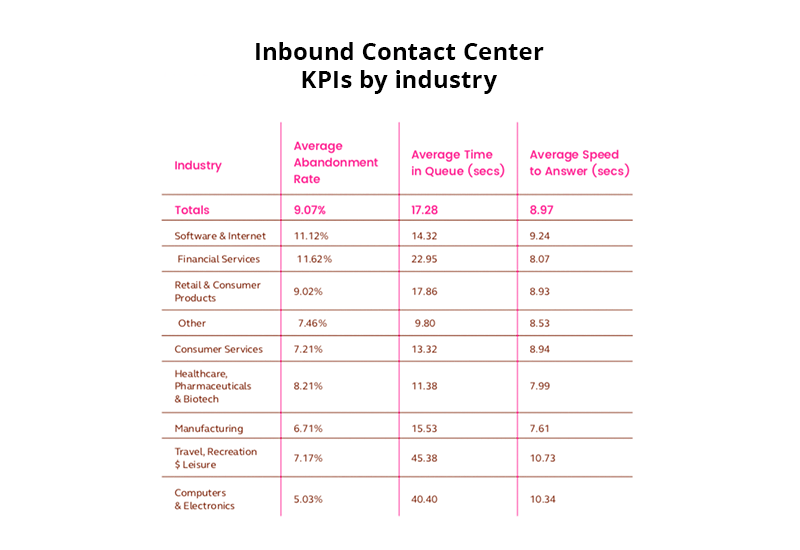A Comprehensive Guide to Call Center Metrics You Need to Measure
Customer service can make or break your business! 58% of consumers consider customer service a very important aspect when it comes to choosing brands. Call centers are usually at the forefront when dealing with customers and providing them with answers and solutions to their queries.
Therefore the performance of your call center is vital to your company’s success.
That’s why we’ve created a guide on the top call center metrics to track. We’ll first discuss the traditional metrics, then take a look at the new-generation call center metrics.
Call Center Goals: The Foundation of Call Center Metrics
Metrics can be an effective system for evaluating your call center performance. But what should you track? Should you just pick random metrics and start measuring?
To set up a reliable system of performance evaluation, you have to first articulate your goals–both strategic and tactical. Your goals will set a standard for you to measure going forward. Based on that standard, you can align your contact center metrics with your business objectives.
Ask yourself the following questions to determine your call center performance metrics:
- How does each action contribute towards achieving your goal?
- What are the financial impacts of these actions?
- What will be the best way to measure those actions?
- Do you want quantitative or qualitative call metrics?
Now we’ll discuss some traditional call center metrics industry standards. Most of these are quantitative methods to measure your call center performance.
First Contact Resolution: The Top Call Center KPI

60% of call centers measure First Contact Resolution (FCR). This metric can disclose:
- Your agent’s capacity to solve problems (on the first call)
- How well they can answer questions
- How many cases are closed on the first call
If your FCR is favorable, it means you’re getting things right on the first attempt. High FCR also leads to customer loyalty and a growth in profit.
Note that FCR only takes into account calls that are solvable at first contact (like canceling subscriptions, changing KYC details, booking upgrades, and so on).
How to measure: Total number of FCR calls / Total number of calls
Metrics Based on Call Center Statistics: Call Abandonment Rates
How many customers hang up before speaking to your agents?
Statistics show a whopping 67% of callers hang up while waiting for an agent to answer. And this has a big impact on your call center profitability. 91% of customers don’t complain, they just opt for your competitor.
So, the lesser your call abandonment rates, the higher your customer satisfaction and revenue.
Call center statistics show that you should have a call abandonment rate of 5%. Some ways to reduce call abandonment include:
- Notifying callers about expected waiting times
- Using self-help portals and knowledge bases
- Setting up an effective IVR system
- Reducing hold times
- Using call center technology to automate call routing
How to measure: Number of abandon calls / Total incoming calls
Measure Efficiency By Service Level & Average Speed of Answer (ASA)

62.7% of call center professionals consider ‘Service Level’ to be a major call center KPI. You will most definitely sign a ‘Service Level Agreement’ with your client, and you must live up to it.
Service level is a set number of calls to be answered within a set number of seconds. Let’s say your service level goal is 60/20–that means you aim to answer 60% of calls within 20 seconds or 5-7 rings. The faster your agents pick up the call; the higher your service level is.
Call center metrics best practices show that most organizations strive for a service level of 80/20 or 80/30.
How to measure: Report your Service Level as a percentage
Now, let’s come to ASA. Average Speed of Answer is simply the number of seconds your agents take to answer a call. You should track it alongside service level for a better understanding of your call center performance.
How to measure: Total time taken to answer / Total number of calls
Financial KPI Call Center: Cost per Call (Contact)
Cost per call is one of the most important call center statistics to track. The metric can reveal the costs associated with handling a call, down to the smallest of expenses. All top call centers aim to achieve a low cost per call.
How to measure: Total calls per hour / Call representative’s hourly wage
You can also track your annual cost per call for purposes like creating your yearly budget. This call metric is also important in comparing the performance of one contact center with another.
Annual cost per call takes into account additional factors like:
- Cost of facilities
- Wages of agents and supervisors
- Benefits and incentives
- Overhead
- Maintenance expenses
How to measure: Operating costs (annual) + labor / Total number of calls in the year
Track Growth with Call Quality

If your agents are able to deal with your customers efficiently, you can expect a growth in profit. Call quality is a handy KPI when it comes to measuring how well agents deal with customers.
You can have your own set of criteria to determine call quality. It’s not uncommon for call centers to include ten criteria, including FCR. You may also consider how agent greet customers, drive them to solutions, and close calls.
How to measure: Amount of criteria met / Total number of criteria
You should also analyze your call quality with data from other sources. Call monitoring, and call tracking solutions like CallGear help you assess how well your agents are performing. You can also take advantage of speech analytics and call transcripts to determine call quality.
Customer surveys are also a good way to gauge how well your agents are performing.
Now, we will take a look at some second-generation call center metrics.
Second-Generation Call Center Metrics
Second-generation metrics are ideal for present-day call centers. The metrics take various factors into account like:
- Omnichannel communication
- Data from other sources
- Customer behavior
- Other qualitative aspects
Typically, these metrics require technology and some form of call center solution like CallGear.
Let’s explore a few next-gen metrics you can consider.
Contribution Metrics: Measure Your Financial Potential
Contribution metrics are ideal for tracking the financial goals of your contact center. You’ll need to focus on your costs, profitability, revenue, and investments to develop your contribution metrics. It’s a great way to figure out the financial impact of your contact center.
Revenue Metrics
Here are some metrics that impact your revenue:
- Customer lifetime value
- Revenue per call
- Revenue per agent
- Revenue per customer
- Customer retention
Also, don’t forget to measure the up-sell and cross-sell attempts using speech analytics software like CallGear.
Cost and Profitability Metrics
The following metrics are suitable to get a clear picture of your costs and profitability:
- Cost of contact per channel
- Cost per agent
- Agent retention rate
- Cost of recruiting and training
- Hourly costs
- Cost of software maintenance and upgrades
Metrics for Call Center Change
The technology around call centers is constantly evolving. The technology you’re using today may not be effective next year. So how do managers prove they need a change?
Well, that can also be done through metrics. Try to determine the aspects that result in direct cost or labor savings. Maybe you can show how the new technology could increase revenue. Or, maybe the new software reduces your cost per agent.
You can use the following ways to demonstrate cost savings:
- Less agent requirements
- Reduced IT or maintenance expenses
- Faster call closing rates
- Reduced analysis and reporting costs
Customer Delight: Metrics for Business Growth

Customers today don’t want to just be satisfied; they want to be delighted! Customer delight metrics show if your call center excels at customer service and can take customer relationships to the next level.
Delighted customers are not just loyal, but also pay a higher price for premium services. You can use a mix of customer satisfaction and agent performance metrics to get your customer delight score.
Some customer delight metrics are:
- FCR
- Average time to answer
- Levels of highest customer satisfaction (track through call recordings and customer surveys)
- Abandonment rate
Wrapping Up
Using call center or call management solutions like CallGear, you can automatically track your performance. You can measure top call center KPIs and run reports to get a complete picture of how your contact center is doing. But first, remember to chalk out your business goals clearly!